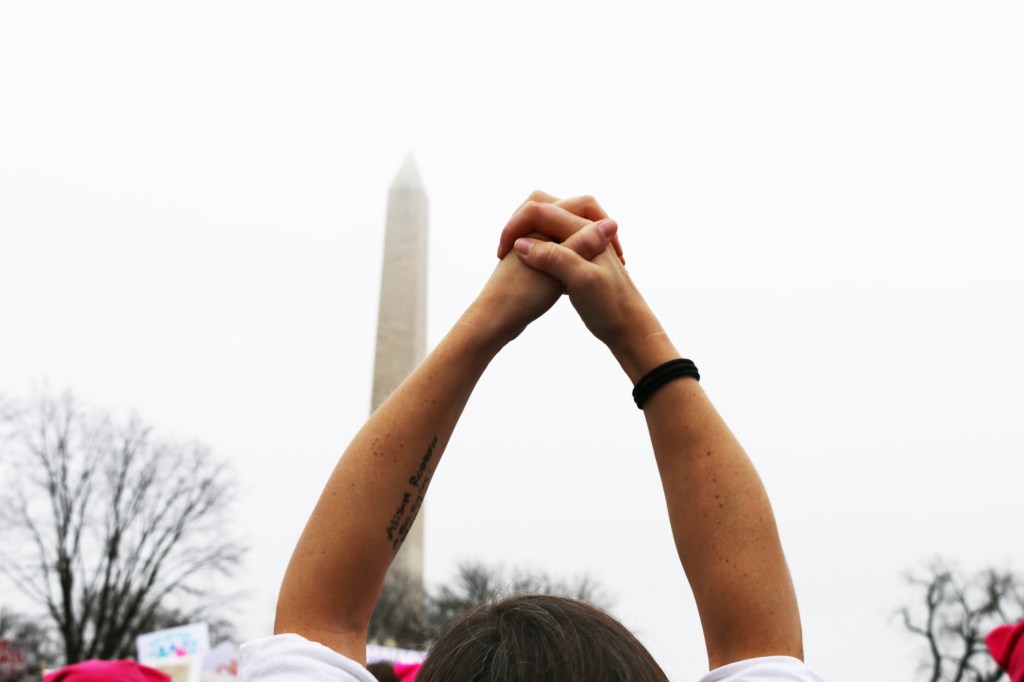The music makes you march, chant, or shout, welcoming you to step out for the first time with a placard, or driving you toward grim resolve. It challenges you to fight harder and better—and to dance. Protest music assumes its different forms over the course of generations, movements, and artistic refinements, to welcome all sorts of people to the struggle, to give hope, and to say things you can say, sometimes, only with a drum.
In the United States, says Alison Rodden, “Women, girls—a lot of us have personal stories where it came time to select an instrument, we wanted drums, and we were offered a flute, clarinet, or violin. In this country, it’s an instrument that’s dominated by one gender over another. So for us, it was an honor to be able to take part in the march as a full women’s drum ensemble.” For two percussion bands that marched the avenues during the January 21, 2017 Women’s March on Washington, drumming advanced two long traditions of political music: Afro-Brazilian Samba-Reggae, for the D.C. band Batalá Washington; and the pungmul, for Chicago’s Korean American Resource and Cultural Center (KRCC). They also brought, like the March as a whole, a mixture of political and aesthetic views, community ideals, and attitudes toward speaking out.
Videos by VICE
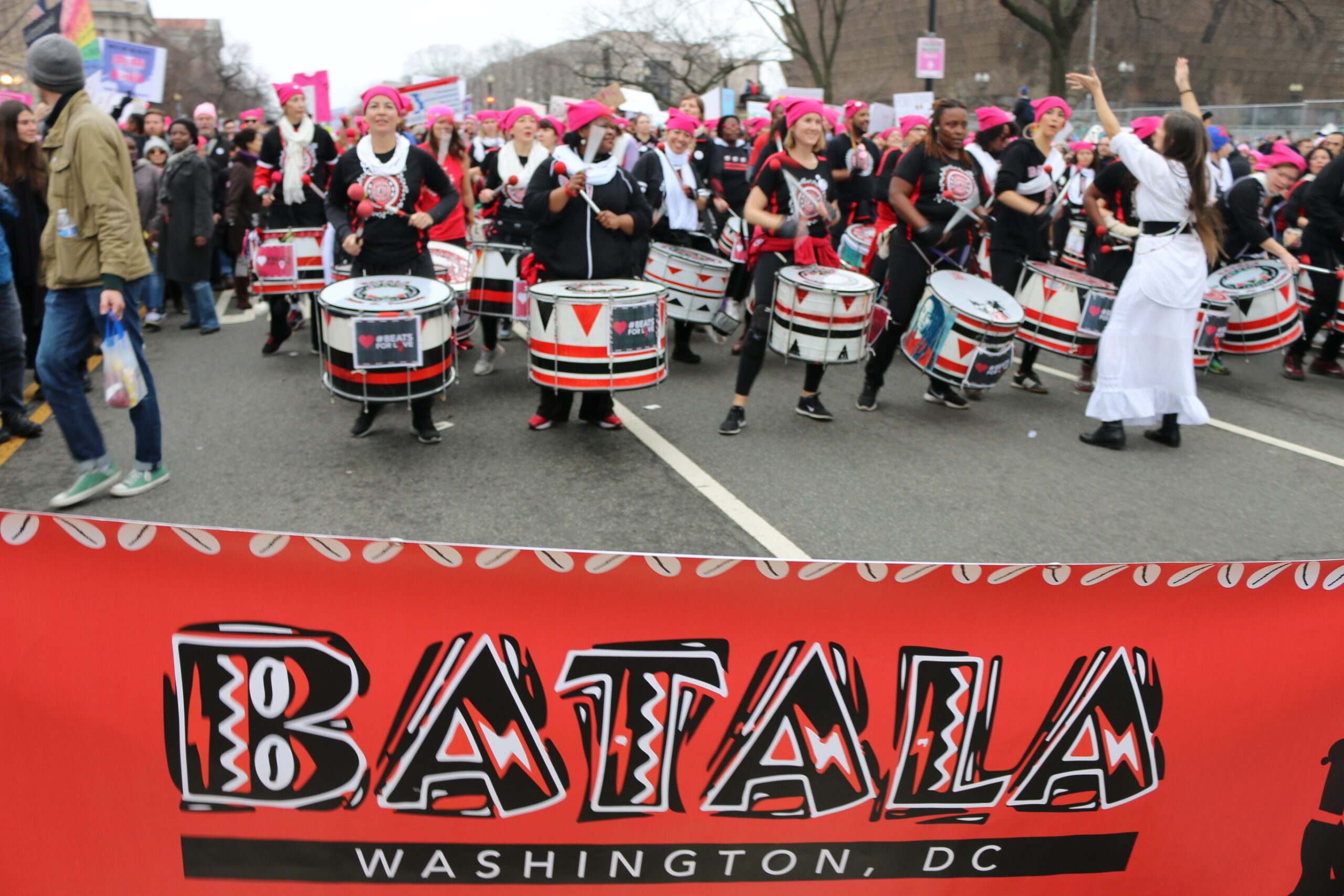
Rodden, the musical director and conductor of Batalá Washington, imagined the Samba-Reggae drums’ effect on listeners at the march: as far as two miles away, people could hear the roll of the big bass drums, the surdos. Closer at hand, the sixty-six drums’ polyrhythms and syncopations resolved into a conversation: between the dobra, the mid-range bass drums that carried melodic lines; the repique, the high-pitched tom drums; and the caixa, or snare drum, the crossover from European music.
The drums’ call and response also called out to other marchers. “The band would lay down a beat, and the participants in the march would start up their own call and response. For example, ‘Our body, our choice,’ to our Samba-Reggae beat, and they’d respond, ‘Her body, her choice.’ It was super fun to bring out different drums and different rhythms.”
The music’s history is the history of Afro-Brazilian people’s struggles for civil rights and reclamation of their musical heritage, from West African rhythms, through the religious drumming of Candomblé, up through the Bahian Black Pride movement. The music belongs to neighborhoods; Batalá Washington is allied to the community of Pirajá, where all the band’s costumes and instruments are made. Band member Brandi Stevenson, who plays the dobra, said that six and a half years of playing Samba-Reggae, and visiting the state that created it, have transformed her perspectives on history and culture.
“I’m originally from New York, in a city that has every race, creed, and color possible, but landing in Bahia, and literally seeing ninety percent of the population looked just like me: it made a very big impact on me…. Every time I strap on a drum, I’m doing my part to educate people about Afro-Brazilian culture and history.”
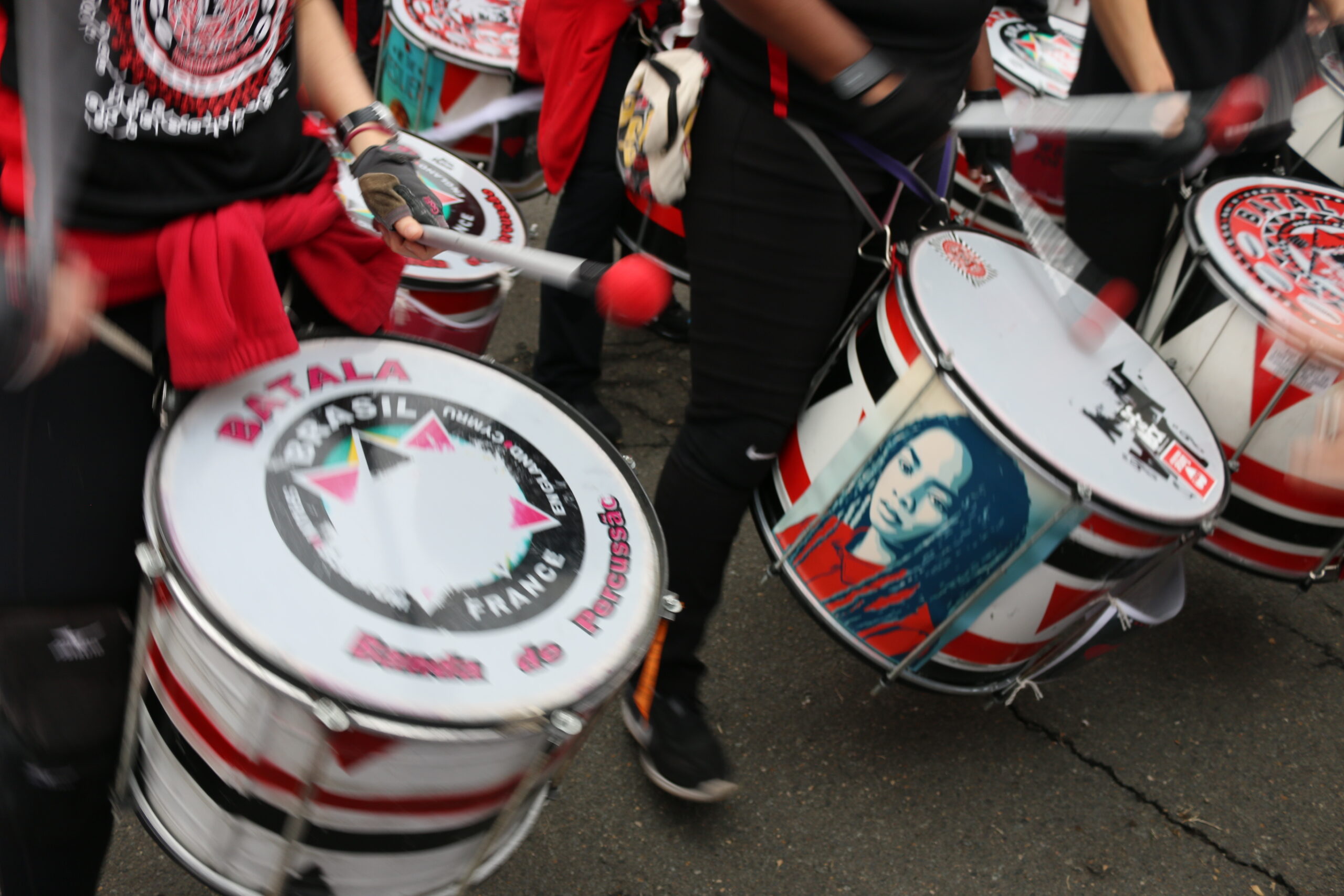
Pirajá is also the home of Batalá Washington’s sister band, Cortejo Afro, the first Samba-Reggae group in Bahia’s capital, Salvador, to welcome both women and LGBTQ musicians. A few other all-women Samba-Reggae ensembles exist, but Batalá Washington is the only one whose leadership is also all-women, which they say includes anybody who self-identifies as a woman, including transwomen.
Rodden says, “If you look at our band, you see America,” referring to Batalá Washington’s ethnically and racially diverse membership. Their mission is feminist and aesthetic: women’s empowerment through the promotion of Afro-Brazilian musical culture. That was why they joined the Women’s March. Caixa drummer Cait Nordehn said that at the March, “This one song we were playing, this rhythm, it just kind of buzzed differently. I was starting to hear people’s chants through the music, even though people weren’t chanting…. There was the power of the marchers behind us that made the music sound different, cohesive.”
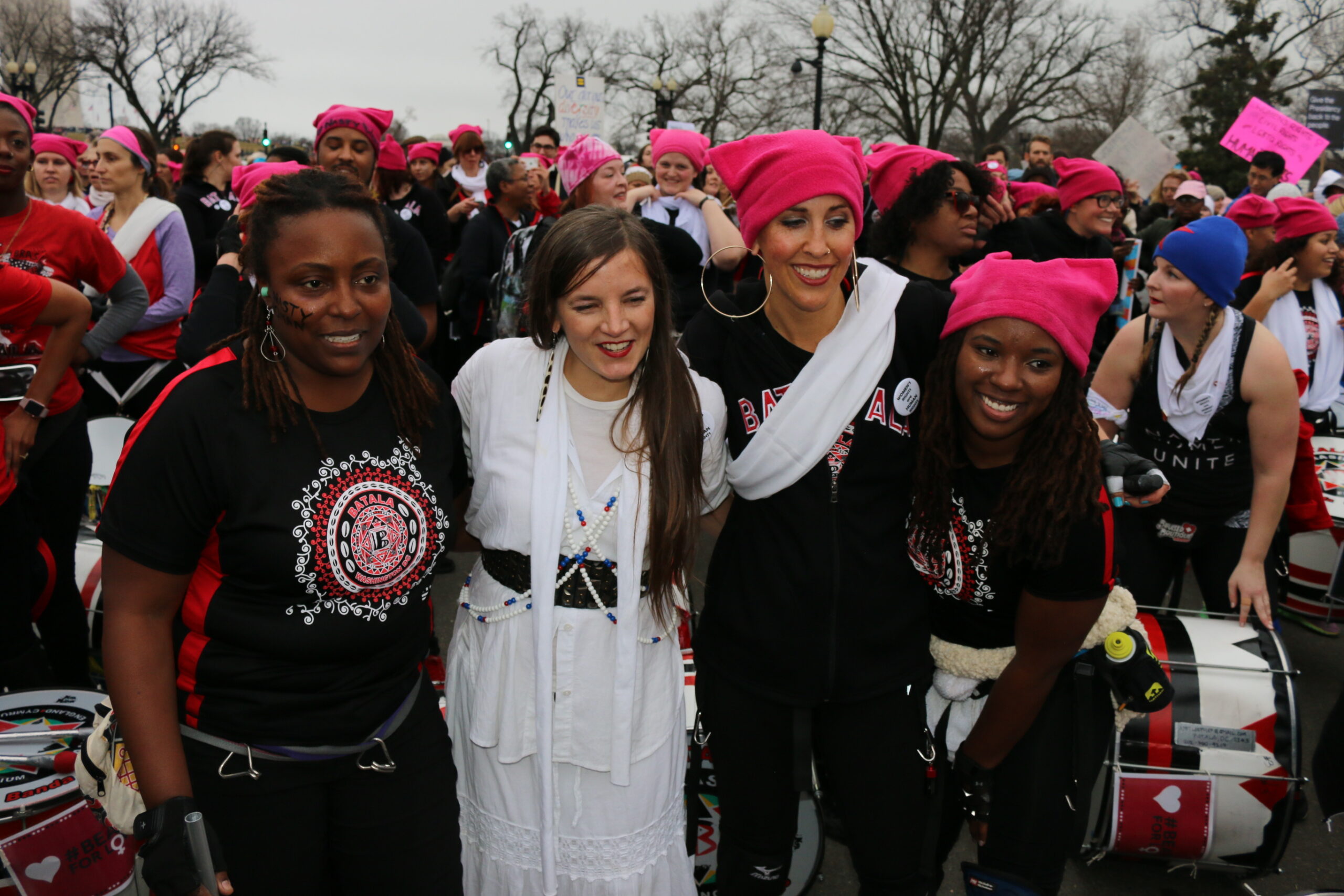
Stevenson also felt that power. “This was the first show that literally gave me chills…. This one, we played nonstop for five hours. Usually, if we play that long, we try to switch out, but everyone was playing on pure adrenaline, everyone played the full five hours…and that had to do with the energy we felt from people out there.”
Another distinction of Batalá Washington is how, in a politicized city and divided nation, they’re trying to be unabashedly feminist, to promote the art form they love—and, simultaneously, to separate the members’ political or partisan convictions from any association with the band. Stevenson came closest to a political expression when speaking of “What I call ground zero, which is Washington, D.C. Not that our country isn’t affected—but D.C. is directly affected. You can feel it in the city, this unspoken energy. And what I would hope is, through our music and our performances, and the energy we give off, when times do get kind of…” she paused, “frustrating, that we can impart some kind of happiness.”
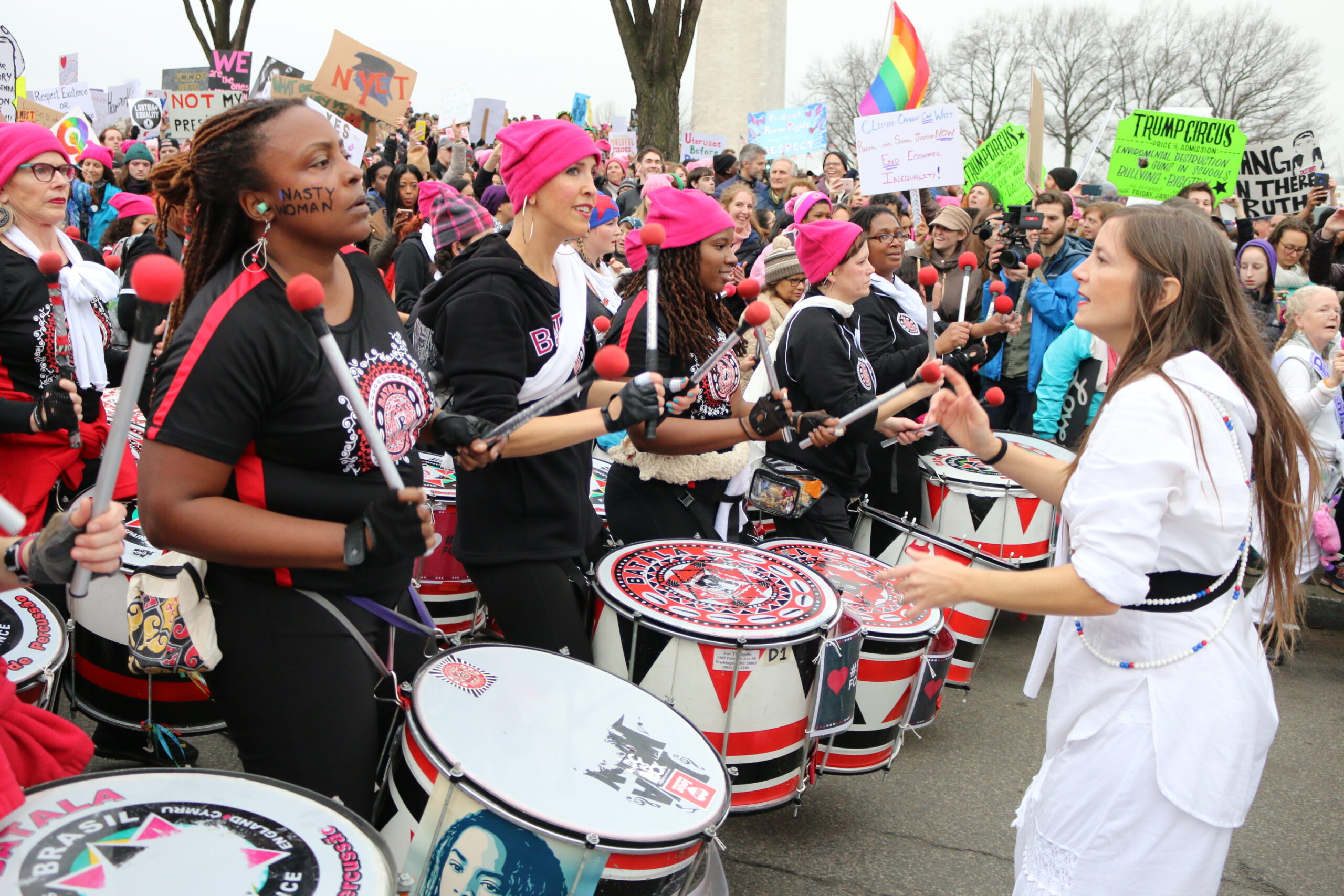
“My favorite part about pungmul is the fact that you can strap a drum on your body and take it to the streets,” said Yujin Maeng of the Korean American Resource and Cultural Center, who played the Ching (large gong drum) and the Buk (barrel-shaped bass drum) during the March. “It’s a way to situate my body, being in a protest, and having that be the Korean-American experience. It felt celebratory—but it also felt pushing and driving.”
Pungmul is a traditional Korean farmers’ musical form, originally played at harvesttime, explained Inhe Choi, Executive Director of KRCC, a Chicago affiliate of the National Korean American Service & Education Consortium (NAKASEC), who played the Changgo (an hourglass-shaped drum). The pungmul’s four instruments, including the K’kwaenggwari, or small gong, represent the sounds of lightning, rain, wind, and clouds. During the Japanese occupation of Korea, which banned public gatherings, music-making remained one of the few opportunities for people to gather outdoors: pungmul was how they resisted. Koreans re-embraced the form during the democracy movement of the 1980s.

Out on the streets, the pungmul played a steady, slow, resolute beat that made you feel like you could—and must—march forever. The effect of the beats, and of the penetrating bass notes of the Ching, completely eludes the video recordings of the event. (For confirmation of what I’d heard, I consulted Drew Daniel*, of the electronic music duo Matmos, with whom I found myself marching. “I loved their stately pace and big resonant gong, it made things a little ominous, like a Javanese court gamelan crossed with industrial percussion legends Crash Worship—it also made a great metronomic grid on which to place chants. They ruled!”)
Then, suddenly, the band beat the cadence of “This is what democracy looks like,” picking up a dying chant, amplifying it, and getting everybody around them to yell louder.

“If you can keep up with the beat, you can play. That’s the beauty of the art form: you can be artistic as possible, but it’s really communal,” said Choi.
KRCC’s roots are in the Korean-American community but the organization welcomes and advocates for the multi-ethnic youth of Chicago, some of whom came on the van to D.C., to be joined by additional youths from Virginia, New York, and Philadelphia. One youth group member, Marisol Rodriguez, said, “Some days I would get to KRCC in a horrible mood, after a terrible day at school, but drumming would lift my spirits and help me get through the rest of the day. I think since the drums are so loud and so energetic, many people find pungmul to be very exciting and uplifting—and difficult to ignore. For those reasons, I think the instruments and the music fit so well with marches and other forms of demonstrations. They bring energy and are unapologetically loud…. I remember drumming at a different demonstration in D.C. and seeing Korean seniors, and eventually other people present, begin dancing and drawing energy from the music. Another thing that I love about playing at demonstrations is seeing other people, with their own instruments, join in. The different sounds from different cultures coming together in the name of resistance is something I find incredibly awe-inspiring.”

Another KRCC youth group member, Maya, said, “I marched because it’s crucial that we all stand in solidarity against all the injustice and hate towards marginalized groups. As a woman of color who cares [about] my rights and the rights of people who are most vulnerable in our communities, I march…. Playing the traditional drums with fellow youths still made me feel as if our presence and visibility were amplified. I’ll never forget the experience.”
Maeng, who is KRCC’s Immigrant Rights and Youth Organizer, said, “When I engage with our youth, a lot of our conversation isn’t focused on identity…but what are the systems of oppression that link us, or divide our communities, or perpetuate oppression? What can we do to fight back against that, in the neighborhoods of Chicago, to work in the framework of anti-oppression? We’re not trying to be single-issues people.”

“We began as an immigrants’ rights organization,” said Choi, who spoke of KRCC’s work for the Deferred Action for Childhood Arrivals. 65% of Korean Americans are recent immigrants and one in six are undocumented; a quarter of the community in greater Chicago are low-income. “We’re out to protect our young people, and also other undocumented people afraid of what’s coming. We’re led by that—but we’re also women. Low-wage workers. Victims of domestic violence and sexual assault. We can be queer, we can have disabilities. Immigrants are all of that, and people of color. But as East Asians, there’s race privilege that we have to be mindful of. With Latinos and Black people, we need to learn more and build alliances.”
It’s no surprise that this group should offer some constructive challenges to the larger movement represented by the march—especially from the youth group, who yearned for solidarity, but had some profoundly alienating experiences with other marchers. Rodriguez said, “As if we were there for them and not ourselves, or as if they were the gracious hosts and we were just guests, as if we were robots and not human beings that needed to rest, as if we were there for their entertainment, as if it was so difficult to ask what kind of drums we played instead of making assumptions.”

Another youth group member, Sameerah Haque, said, “As a child of immigrant parents, a Muslim, and a woman, listening to Trump belittle these groups of people and many more made me frustrated and angry. This march was a place for me to show that I wouldn’t support someone so hateful, while also finding comfort that millions of others feel the same…. [It] was a heartwarming experience that was a ray of hope during such a fearful and worrisome time.”
However, Haque added, “One thing that was disheartening was the number of people who would treat our form [of] protesting as entertainment. But that just made me want to continue to drum and march even more. Different groups of people have protested in various ways, so they shouldn’t be seen as exotic or weird, or unique, following their traditions and culture. By continuing to march and drum pungmul, I hope to normalize one of many ways people protest.”

The white feminist pushback against such critiques—from people of color, especially Black feminists, and transgender people and disabled people—has been harsh. But a movement that can’t listen to such hopeful, constructive suggestions for kindness and openness isn’t ready to counter the threats of the next four years, or to fight for those who are most vulnerable.
Choi spoke of the pungmul as a form of dissent, as a safe space for the folks of color playing or listening to the music, as a welcome to people willing to fight alongside them, and as one more step forward in forging new alliances. “What was beautiful about this march was, there’s a lot of people who never did anything like this, who came out. It was very positive that those who didn’t do anything, or were apathetic, were able to take action. Rather than being upset about this experience…it’s amazing that you all come out! So, when we have a Mayday immigration march, when there’s a Black Lives Matter protest? You should come out. We can build on it and continue to mobilize and converge. That’s what we’re going to be remembering, as we continue to do this work.”
Alison Kinney is fighting back on Twitter.
Batalá photos by Sonova Middleton
Batalá video by Anne AR, Explicite, Journalistes Associés
KRCC/NAKASEC photos courtesy of KRCC/NAKASEC
More
From VICE
-

Jesus, Mary Magdalene, Judas Iscariot, and some fourth wheel at the Last Supper (All photos by Paige Taylor White) -

Cole and Calvin, cousins, 2017. All photos courtesy of the artist and Dallas Contemporary. -

Collage by VICE -

Lauren Levis, who died after taking iboga at the Soul Centro retreat in 2024. (Photo courtesy of the Levis family)
